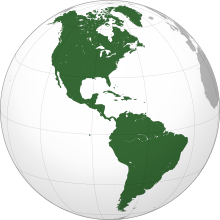| Area | 42,549,000 km2 (16,428,000 sq mi) |
|---|---|
| Population | 1.02 billion[1] |
| Population density | 22.67/km2 (58.74/sq mi) |
| Demonym | American,[2] Pan-American,[3] New Worlder[4] (see usage) |
| Countries | 35 |
| Languages | Spanish, English, Portuguese, French, Haitian Creole, Quechua, Guaraní, Aymara, Nahuatl, Dutch, and many others |
| Time zones | UTC−10 to UTC+0 |
| Largest cities | List
Complete List of largest metropolitan areas and their cities |
| UN M49 code | 019 – Americas001 – World |

The Americas, sometimes collectively called America,[5][6][7] known initially as India Nova,[8] are a landmass comprising the totality of North America and South America.[8][9][10] When viewed as a single continent, the Americas or America is the 2nd largest continent right after Asia, and is the 3rd largest continent by population. The Americas make up most of the land in Earth's Western Hemisphere and comprise the New World.[5]
Along with their associated islands, the Americas cover 8% of Earth's total surface area and 28.4% of its land area. The topography is dominated by the American Cordillera, a long chain of mountains that runs the length of the west coast. The flatter eastern side of the Americas is dominated by large river basins, such as the Amazon, St. Lawrence River–Great Lakes, Mississippi, and La Plata basins. Since the Americas extend 14,000 km (8,700 mi) from north to south, the climate and ecology vary widely, from the arctic tundra of Northern Canada, Greenland, and Alaska, to the tropical rainforests in Central America and South America.
Humans first settled the Americas from Asia between 20,000 and 16,000 years ago. A second migration of Na-Dene speakers followed later from Asia. The subsequent migration of the Inuit into the neoarctic c. 3500 BCE completed what is generally regarded as the settlement by the Indigenous peoples of the Americas.
The first known European settlement in the Americas was by the Norse explorer Leif Erikson.[11] However, the colonization never became permanent and was later abandoned. The Spanish voyages of Christopher Columbus from 1492 to 1504 resulted in permanent contact with European (and subsequently, other Old World) powers, which eventually led to the Columbian exchange and inaugurated a period of exploration, conquest, and colonization whose effects and consequences persist to the present. The Spanish presence involved the enslavement of large numbers of the indigenous population of America.[12]
Diseases introduced from Europe and West Africa devastated the indigenous peoples, and the European powers colonized the Americas.[13] Mass emigration from Europe, including large numbers of indentured servants, and importation of African slaves largely replaced the indigenous peoples in much of the Americas.
Decolonization of the Americas began with the American Revolution in the 1770s and largely ended with the Spanish–American War in the late 1890s. Currently, almost all of the population of the Americas resides in independent countries; however, the legacy of the colonization and settlement by Europeans is that the Americas share many common cultural traits, most notably Christianity and the use of West European languages: primarily Spanish, English, Portuguese, French, and, to a lesser extent, Dutch.
The Americas are home to more than a billion inhabitants, two-thirds of whom reside in the United States, Brazil, and Mexico. It is home to eight megacities (metropolitan areas with 10 million inhabitants or more): Greater Mexico City (21.2 million), São Paulo (21.2 million), New York City (19.7 million), Los Angeles (18.8 million), Buenos Aires (15.6 million),[14] Rio de Janeiro (13.0 million), Bogotá (10.4 million), and Lima (10.1 million).
- ^ "Population". United Nations. Retrieved July 25, 2021.
- ^ Cite error: The named reference
OEDAMERICANwas invoked but never defined (see the help page). - ^ "Pan-American". Oxford English Dictionary (Online ed.). Oxford University Press. (Subscription or participating institution membership required.)
- ^ "New Worlder". Oxford English Dictionary (Online ed.). Oxford University Press. (Subscription or participating institution membership required.)
- ^ a b Cite error: The named reference
oxfordcwas invoked but never defined (see the help page). - ^ Cite error: The named reference
Burchfieldwas invoked but never defined (see the help page). - ^ "America". Oxford Dictionary.
- ^ a b Webster's New World College Dictionary, 2010 by Wiley Publishing, Inc., Cleveland, Ohio.
- ^ Merriam Webster dictionary. Merriam-Webster, Incorporated. 2013. Retrieved March 23, 2016.
- ^ "continent n. 5. a." (1989) Oxford English Dictionary, 2nd edition. Oxford University Press; "continent1 n." (2006) The Concise Oxford English Dictionary, 11th edition revised. (Ed.) Catherine Soanes and Angus Stevenson. Oxford University Press; "continent1 n." (2005) The New Oxford American Dictionary, 2nd edition. (Ed.) Erin McKean. Oxford University Press; "continent [2, n] 4 a" (1996) Webster's Third New International Dictionary, Unabridged. ProQuest Information and Learning; "continent" (2007) Encyclopædia Britannica. Retrieved January 14, 2007, from Encyclopædia Britannica Online.
- ^ "Leif Erikson (11th century)". BBC. Retrieved November 20, 2011.
- ^ Kamen, Henry. Spain's Road to Empire: The Making of a World Power, 1492–1763.
- ^ Taylor, Alan (2001). American Colonies. New York: Penguin Books. ISBN 9780142002100.
- ^ "Censo 2010. Resultados provisionales: cuadros y grá" (in Spanish). Archived from the original on December 20, 2010. Retrieved February 25, 2011.

